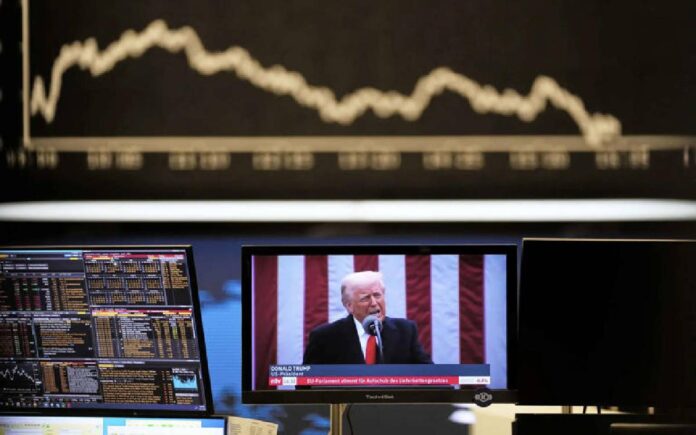Washington, D.C.: At 12:01 a.m. Eastern Time on Saturday, U.S. customs officers began enforcing former President Donald Trump’s new 10% “baseline” tariff on imports—marking the most transformative change in American trade policy since the Second World War.
But this is only the beginning. Starting April 9, even steeper tariffs—ranging from 11% to 50%—will be imposed on imports from 57 countries, including long-standing allies such as the UK, Japan, and the European Union.
“This is the single biggest trade action of our lifetime”, said Kelly Ann Shaw, trade lawyer and former White House adviser under Trump, at a Brookings Institution event. “This is a pretty seismic and significant shift in the way that we trade with every country on earth”.
Global Markets Recoil, China Strikes Back
Markets around the world responded swiftly—and sharply. Within two days of Trump’s announcement, over $5 trillion was wiped from S&P 500 companies, oil and commodity prices plummeted, and investors scrambled toward safer assets like government bonds.
In a swift response, China, facing a compounded 54% tariff, announced reciprocal measures. From April 10, it will impose a 34% levy on U.S. exports, initiate a case at the World Trade Organization, and restrict exports of rare earth metals—essential to global electronics and medical sectors.
Meanwhile, other U.S. trade partners have adopted a more cautious approach, closely monitoring the fallout and considering their own strategic responses.
Narrow Exemptions, Broad Consequences
Despite the sweeping scope of the new tariffs, more than 1,000 product categories—including crude oil, semiconductors, pharmaceuticals, uranium, copper, and titanium—have been temporarily exempted. These sectors, worth $645 billion in U.S. imports in 2024, are currently under further review for potential national security tariffs.
Industries already subject to 25% duties, such as steel, aluminum, and automobiles, are not impacted by this latest round. Likewise, Canada and Mexico are excluded from the new policy but remain affected by prior 25% tariffs related to compliance with the US-Mexico-Canada Agreement (USMCA) and broader geopolitical issues like immigration and fentanyl trafficking.
Even Vietnam, once a beneficiary of the U.S.-China trade decoupling, has been hit with a staggering 46% tariff. Talks between Hanoi and Washington are now underway in hopes of averting an extended dispute.
No Grace Period, Limited Relief
The new rules went into effect without a grace period. Australia, the UK, Colombia, Argentina, Egypt, and Saudi Arabia are among the countries feeling the pressure first. However, goods already en route before the deadline have until 12:01 a.m. ET on May 27 to arrive—after which they too will face the new 10% tariff.
Analysts warn of far-reaching consequences. Oxford Economics predicts that these changes will push the average U.S. tariff rate to 24%—the highest since the Great Depression.
“If they can’t get a reprieve”, Oxford Economics cautioned, “they are likely to retaliate, as China already has”.
Europe and Asia Weigh Retaliation
While some countries have adopted a wait-and-watch strategy, retaliation may not be far off.
“If they can’t get a reprieve, they are likely to retaliate”, reiterated Oxford Economics.
The European Union has hinted at countermeasures, with Trade Commissioner Maros Sefcovic stating that the bloc would respond in a “calm, carefully phased, unified way”, but emphasized, “we won’t stand idly by”.
France and Germany have suggested taxes on U.S. tech giants in response. Meanwhile, Japan’s Prime Minister called for a “calm-headed” response after Japan was hit with a 24% tariff.
Auto manufacturer Stellantis, which owns Jeep, paused production at factories in Canada and Mexico following the latest 25% auto tariffs.
Trump has cited progress in talks with foreign leaders.
“Very productive”, he said of a recent call with Vietnam’s leadership—despite the country facing one of the steepest new duties.
A Break From Post-War Trade Norms
With this policy shift, Trump has abandoned the post-WWII model of multilateral trade negotiations, instead invoking emergency economic powers to pursue what he calls “reciprocal” trade. The administration blames chronic trade deficits on global imbalances and unfair tax systems.
Experts, however, draw stark comparisons to the 1930 Smoot-Hawley Tariff Act, which many historians argue deepened the Great Depression. The current policy, they say, could similarly strain global supply chains, fuel inflation, and lead to widespread retaliation.
Oxford Economics projects a 24% average U.S. tariff rate, higher than at any point in the past century. Additional measures include a 25% auto tariff and another 20% on select Chinese imports, totaling a 54% duty on Chinese goods by April 9.
Despite mounting economic concerns, Trump has remained defiant.
“My policies will never change”, he posted on his social platform.
As global leaders weigh their options, the world is left to ask: Will they retaliate, negotiate, or ride out the storm?
Because the tariffs are here, the countdown has begun—and the ripple effects are already being felt.



